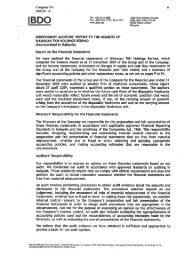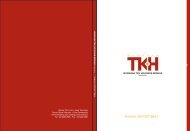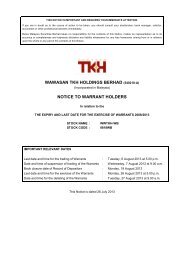ANNUAL REPORT 2012 - Wawasan TKH Holdings Berhad
ANNUAL REPORT 2012 - Wawasan TKH Holdings Berhad
ANNUAL REPORT 2012 - Wawasan TKH Holdings Berhad
You also want an ePaper? Increase the reach of your titles
YUMPU automatically turns print PDFs into web optimized ePapers that Google loves.
WAWASAN <strong>TKH</strong> HOLDINGS BERHAD (540218-A)<br />
<strong>ANNUAL</strong> <strong>REPORT</strong> <strong>2012</strong><br />
051<br />
NOTES TO THE FINANCIAL STATEMENTS<br />
31 DECEMBER <strong>2012</strong> (cont’d)<br />
4. SIGNIFICANT ACCOUNTING POLICIES (cont’d)<br />
4.12 Borrowing costs<br />
Borrowing costs that are directly attributable to the acquisition or production of a qualified asset<br />
is capitalised as part of the cost of the asset until when substantially all the activities necessary to<br />
prepare the asset for its intended use or sale are complete, after which such expense is charged to<br />
profit or loss. A qualifying asset is an asset that necessarily takes a substantial period of time to get<br />
ready for its intended use or sale. Capitalisation of borrowing cost is suspended during extended<br />
periods in which active development is interrupted.<br />
The amount of borrowing costs eligible for capitalisation is the actual borrowing costs incurred on<br />
the borrowing during the period less any investment income on the temporary investment of the<br />
borrowing.<br />
All other borrowing costs are recognised in profit or loss in the period in which they are incurred.<br />
4.13 Income taxes<br />
Income taxes include all domestic and foreign taxes on taxable profit. Income taxes also include<br />
other taxes, such as withholding taxes, which are payable by a foreign subsidiary on distributions<br />
to the Group and Company, and real property gains taxes payable on disposal of properties.<br />
Taxes in the income statements and statements of comprehensive income comprise current tax and<br />
deferred tax.<br />
(a) Current tax<br />
Current tax expenses are determined according to the tax laws of each jurisdiction in which the<br />
Group operates and include all taxes based upon the taxable profits (including withholding taxes<br />
payable by a foreign subsidiary on distribution of retained earnings to companies in the Group),<br />
and real property gains taxes payable on disposal of properties.<br />
(b) Deferred tax<br />
Deferred tax is recognised in full using the liability method on temporary differences arising<br />
between the carrying amount of an asset or liability in the statement of financial position and<br />
its tax base.<br />
Deferred tax is recognised for all temporary differences, unless the deferred tax arises from<br />
goodwill or the initial recognition of an asset or liability in a transaction which is not a business<br />
combination and at the time of transaction, affects neither accounting profit nor taxable profit.<br />
A deferred tax asset is recognised only to the extent that it is probable that future taxable profits<br />
will be available against which the deductible temporary differences, unused tax losses and<br />
unused tax credits can be utilised. The carrying amount of a deferred tax asset is reviewed at<br />
the end of each reporting period. If it is no longer probable that sufficient taxable profits will be<br />
available to allow the benefit of part or that entire deferred tax asset to be utilised, the carrying<br />
amount of the deferred tax asset will be reduced accordingly. When it becomes probable that<br />
sufficient taxable profit will be available, such reductions will be reversed to the extent of the<br />
taxable profits.<br />
Deferred tax assets and liabilities are offset when there is a legally enforceable right to set off<br />
current tax assets against current tax liabilities and when the deferred income taxes relate to<br />
the same taxation authority on either:<br />
(i) the same taxable entity; or<br />
(ii) different taxable entities which intend either to settle current tax liabilities and assets on a<br />
net basis, or to realise the assets and settle the liabilities simultaneously, in each future period<br />
in which significant amounts of deferred tax liabilities or assets are expected to be settled or<br />
recovered.<br />
Deferred tax would be recognised as income or expense and included in profit or loss for the<br />
period unless the tax relates to items that are credited or charged, in the same or a different<br />
period, directly to equity, in which case the deferred tax will be charged or credited directly to<br />
equity.<br />
Deferred tax assets and liabilities are measured at the tax rates that are expected to apply to<br />
the year when the asset is realised or the liability is settled, based on the announcement of tax<br />
rates and tax laws by the Government in the annual budgets which have the substantial effect<br />
of actual enactment by the end of the reporting period.







